Saying goodbye to a beloved dog is never easy, especially in the midst of the coronavirus crisis. I hope by sharing this personal story of our dog Daisy’s death, we can remember the importance of living with gratitude during these uncertain times.
Sunday, March 15, 2020
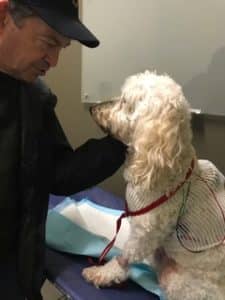 “Who’s a good girl Daisy? Who’s a good girl?” whispered my husband, Mark, to our 13-year old Goldendoodle as he rubbed her neck.
“Who’s a good girl Daisy? Who’s a good girl?” whispered my husband, Mark, to our 13-year old Goldendoodle as he rubbed her neck.
Daisy was dressed in a white mesh vest that kept her blood pressure monitor secure. One of her legs had been shaved where her IV tube was placed. Although she was in an acute animal care hospital, Daisy responded to my husband’s gentle voice by wagging her tail.
“She’s not urinating,” said Dr. K, the hospital veterinarian. “Maybe if you walked her it would help.” Daisy had been wheeled in to see us in the examination room strapped onto a gurney. We had come to visit Daisy on her second day at the hospital. It was Sunday, March 15th, the same day Governor Newsom first announced the stay at home order for Californians.
We nodded and looked at Daisy with a flicker of hope. Maybe if she just peed, it would be all right.
We walked Daisy outside around the concrete patio area of the hospital, pausing here and there to let her sniff. That used to do the trick, but not this time. We took her to the front parking lot where some cars were parked. She went up to the door of almost every car and waited for us to let her in. She wanted to go home.
But we couldn’t bring her home, no matter how much we wanted to. We had rushed her to the hospital the night before because her regular vet said Daisy’s bloodwork showed abnormal kidney and pancreatic values. A few days before, Daisy had stopped eating and had started to vomit. When she got to the hospital, Dr. K said she might have an infection that was affecting her kidneys, so they began treating her aggressively with antibiotics while they ran a bunch of other tests.
Meanwhile, Daisy still wouldn’t pee, even for us. Dr. K was nice enough to meet us outside and showed us a spot that dogs liked. We all walked around the side of the building toward a patch of dirt. Daisy stepped onto the dirt and she urinated so much that her back knees touched the ground. Success! Mark and I smiled with relief. Surely this was a good sign. Dr. K told us to call the next morning.
Monday, March 16, 2020
We called to check in the following day, but the news wasn’t good. Daisy wasn’t responding to the antibiotics and her kidney functions were getting worse. She wasn’t eating or peeing at all. Dr. K said it was probably time to give her a feeding tube and insert a catheter.
We agreed and drove to the hospital immediately. When we arrived, the hospital policies had already changed and they were only letting people in by appointment due to heightened coronavirus restrictions. But the hospital staff let us in to see Daisy, who was now lying down in a cage in the ICU. My heart broke seeing her in such obvious distress. We let her rest, but by evening, Daisy’s condition hadn’t improved. She was starting to bleed internally. Her organs were beginning to shut down.
Dr. K counseled us in an examination room. “We have a window…a crack…to decide whether to help her go. If we let her die naturally, she will soon begin to feel more pain.”
My eyes widened in horror. Tears that had erupted here and there during the day began gushing out. I wiped them with the purple sterile gloves the hospital had provided us earlier. This was happening so fast. The whole world was changing overnight.
“I…I don’t know what we should do,” I stuttered.
Mark squeezed my hand. His eyes looked bloodshot and his shoulders were hunched forward. He had had several dogs as a child and even carried one home who had been run over by a car. He understood. But I never had a dog growing up. And now I was terrified of putting one down.
Dr. K’s eyes softened and she spoke gently. “If you let her die on her own, she would feel fear. She would be in pain, but wouldn’t understand why her body wasn’t working and what was happening to her.”
“I don’t know if I can do it,” I said, my stomach tightening. I couldn’t imagine myself watching her die and being the one to allow it.
“Daisy has served her purpose for you and your family,” said Dr. K. “She would be comforted by having her pack at her side. She would feel safe.”
My wet eyes saw blurry images of Daisy licking our children’s faces while they squealed with glee, nuzzling her wet nose under our arms to play, and bounding to the garage door for walks so we could get outside and enjoy nature. Daisy was an easy-going, joyful dog who had provided our family and everyone she touched with unconditional love and comfort.
So, we made the unthinkable choice – to relieve Daisy of her suffering and put her to sleep.
Dr. K guided us into a private room for families where Daisy was waiting. She was on a doggie bed with a tube coming out of her nose and one blue sock holding her catheter in place. She looked up at us with sad, tired eyes. She rallied and sat up on her hind legs for a few minutes. I kneeled down and gave her a big hug, whispering “I love you Daisy.” Mark comforted her too.
I put Daisy’s head on my lap and gently stroked her head. She relaxed and almost dozed off. But she couldn’t quite go to sleep, not without help. Dr. K rubbed her too, as she inserted a syringe into her IV. I could feel Daisy relaxing instantly. Her breathing evened out, growing stronger before fading away. Her eyes started to droop and her body softened. In a matter of seconds, she became limp.
“Her heart has stopped beating,” Dr. K said, as she touched Daisy’s heart.
Mine stopped too at that moment. But looking down, Daisy seemed completely at peace. She was no longer suffering. The heat coming from her body made me feel that her spirit was still alive, in the room, watching over us and making sure we were okay. I mourned for her, but I believed she was in a better place.
Grief and Hope
The days following Daisy’s death were difficult. Every day seemed empty and different – both because Daisy was gone and the coronavirus was becoming a global pandemic. The family member who would provide so much comfort at this time was the one we were grieving.
I created a little altar at home of Daisy memorabilia and made a small scrapbook. I allowed myself to feel my feelings and be sad. I also tried to meditate and focus on the things I am grateful for. Her death reminded me how quickly things can change and how fleeting life can be. She changed me to be more grateful for the here and now, which in turn has helped me cope with the chaos in the world around me. With COVID-19, I think we collectively have been given an opportunity to reset, and live life in a different, more present way.
Daisy’s ashes arrived home in a simple, biodegradable box yesterday. She underwent an environmentally healthy process of aftercare called Aquamation that uses water instead of flames and heat to cremate remains. The company, Hearts & Halos, also provided a wooden plaque engraved with Daisy’s name and paw print. We requested a lock of her hair, which came tied in a pink rubber band inside a small mesh bag. It was a lovely way to honor Daisy.
A friend said that she has it on “good authority” that in the after, dogs get all the steaks they can eat, and someone they love who will constantly throw a ball or frisbee, whatever their preference. I trust that is true with Daisy. And I pray that we all find gratitude and hope in our altered world, just as Daisy’s death helped me do.
How are you feeling these days? How has the COVID-19 global pandemic changed you?
Please share your thoughts below.
What I’m reading
The Alchemist by Paulo Cuelho
An uplifting book about the spiritual journey of a shepherd boy who learns to listen to his heart and follow his dreams. It’s a magical story that I could read over and over again.
In the Doghouse by Teri Case
A heartfelt, entertaining read about a couple’s breakup from the point of view of the family dog. I could hear Daisy’s voice in Skip!
The Smallest Thing by Lisa Manterfield
Inspired by the true story of the plague of Eyam in England, it has lessons for today as the village is quarantined and villagers must learn what it means to be trapped.




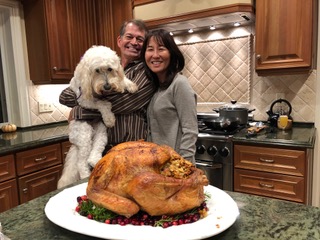



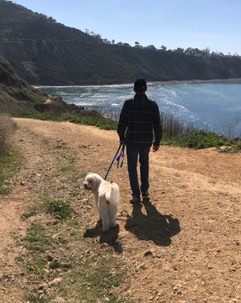
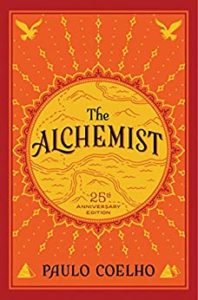
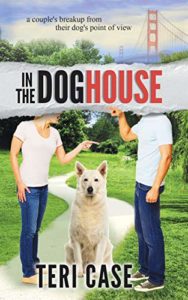


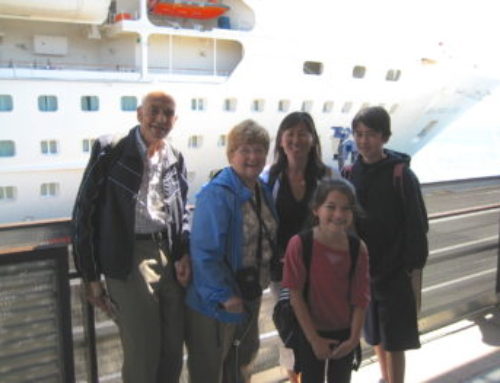

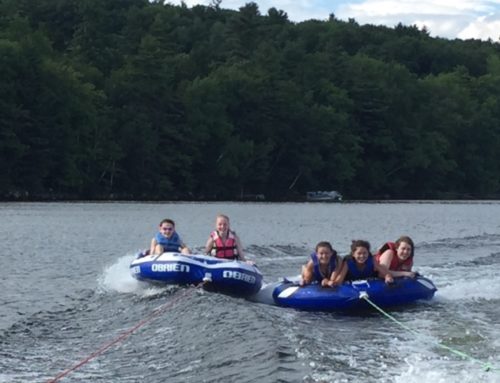
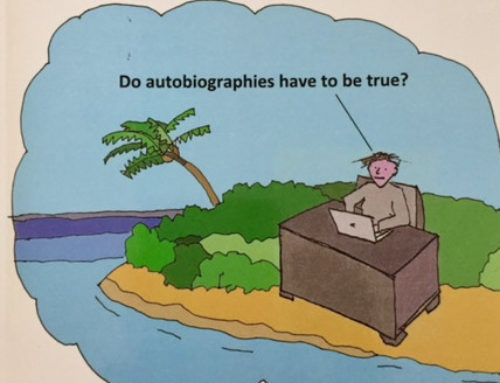

So sad and sorry for your loss, Rosa. Such a hard time to lose her when you could use her comfort.
Thank you Jan. Yes the timing was not great but her loss does help me put everything that’s going on in the world right now in perspective. Stay present and cherish the ones you love now.
Such a powerful story. Thank you for your vulnerability and pointing us all toward gratitude.
Really the only thing that’s helped a lot has been to be grateful for the time we had Daisy and to be grateful for the opportunity we have right now to reset as a world. Thank you my friend.
A beautiful tribute to Daisy…thank you for sharing your journey with us.
I’m sure a lot of people could relate to this journey of losing a pet. Even though Daisy is not here physically, I feel her presence. Writing this has been healing for me. Thanks for reading!
Oh, Rosa – I am heartbroken for you. My deepest condolences to you and your family.
Sending love and hugs.
Wonderful to hear from you Bronnie. These furry creatures become part of your family and there’s a big hole when they leave. It helps to share. Thanks for your love and support.
Rosa, I am so sorry for you and your family. I never had a dog growing up, and got my first one shortly after I got married. He was my first born and loosing him was devastating. They have a way of burrowing their ways deep into our hearts, and the pain is so great when you loose one. I have lost 2 dogs since the first and i continue to do it to myself. They are such an amazing part of our lives that I cannot imagine being without one. We lost our 5 year old in September and not a day goes by that I don’t miss him or think about him. The one thing that helps me get by is knowing that one day I will see them all at Rainbow Bridge. If you do not know what that is, google the poem. It gives hope!! Take care knowing you will see Daisy again at Rainbow Bridge.
I’m so sorry to hear about your 5 year old and all the other doggies you’ve lost. They give such joy and comfort! Another friend just sent me the Rainbow Bridge poem and I do believe that you will meet all yours and I will see Daisy there. Thanks for reading and commenting. Hope your family is doing well.
A beautiful tribute to your beloved Daisy – and yes, doggie heaven is all endless walks, snuggles on the couch, fetch the ball, and treats treats treats. Hope to see you soon – be well.
Love, julie
Thanks for confirming my hunch about doggie heaven. It sounds like a wonderful place. So glad we love dogs and writing. Take good care and hope to see you soon!
I’m crying and stroking Tody’s hair as I read your moving story. Thank you for sharing your loss. You’ve reminded me how precious Toby is and how much he adds to my life.